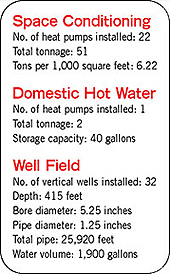
The Hall of Records is the smallest of four buildings on the courthouse site and consists of approximately 10,300 square feet. In October 2003, an interior rehabilitation of the Hall of Records was started, which included the restoration of the 50-foot diameter skylight, fabrication of period furniture, and the installation of a water-source heat pump system to heat and - for the first time ever - cool the building.
The Hall of Records retrofit is expected to run about $2.4 million, with the geothermal system alone costing approximately $250,000. The National Historic Landmark status of the courthouse complex means that great care has to be taken to ensure nothing will impact the historic buildings. The discreet nature of the geothermal system was a perfect fit, as it will keep occupants comfortable, while maintaining the structure's original historic site context, character, and charm.

Historic Status
The entire city block where the Santa Barbara Courthouse is located is considered to be a National Historic Landmark, so it was necessary for everyone involved in the restoration to follow the Department of the Interior standards for the care of historic properties."For me, it was easy," said Robert Ooley, AIA, county architect for Santa Barbara County. "My mandate to both the restoration architect and the mechanical engineer was ‘zero impact to historic resources will occur as a result of the installation of new mechanical equipment.' The two consultants got together and figured out how to deliver the heating and cooling without the loss of a single historic resource."
Because conventional HVAC systems would require the placement of external, therefore visible, components, it was decided that this type of equipment would not comply with the site context requirements.
Water-source heat pump units made sense for this application because the loop field meant that nothing was visible. While the first cost was higher than a conventional system, the payback period is expected to be less than six years.
The construction of the loop field for the Hall of Records' geothermal system began in March 2004. It took 50 days to drill the necessary 32 wells, each of which is approximately 415 feet deep. The small patch of grass where the loop field was installed made for cramped quarters, and one lane of traffic had to be shut down in order to accommodate the drilling rig and all the piping support.
In keeping with the historic status of the building, the original flagstone walkway in front of the Hall of Records had to be mapped for replacement.
In addition, many of the trees and plants around the courthouse were gifts from other countries, so they, too, had to be carefully protected in place so as not to impact the existing landscape.
WaterFurnace (www.waterfurnace.com) manufactured the extended-range water-source heat pump units used in this vertical-closed well system with ground-coupled heat exchange.

As Ooley noted, "In addition to preserving the building's historic character and protecting the environment by not burning fossil fuels, the highly efficient WaterFurnace system is expected to save taxpayers money by reducing annual utility bills from $64,000 to just $1,800."
The Hall of Records was definitely due for an HVAC overhaul. The existing building had never had air conditioning, and the heat supplied by the central steam plant was not reliable. "The Hall of Records was the last section of building on the piping run. It was an old, unreliable steam system, and sometimes the building would have heating and sometimes it wouldn't," stated Conkling.
The old distribution equipment and terminal units were removed, and 23 water-source heat pumps were installed. Most of the units are in the 2-ton range, and they are tucked away in the basement or hidden by custom furniture that was designed especially for the Hall of Records. One water-to-water unit supplies all the heat for the domestic hot water in the building.
Santa Barbara is a temperate climate, but air conditioning became a necessity in the Hall of Records once the original 50-foot diameter skylight was reopened. The skylight was paneled over at some point in time, but with its restoration came higher heat loads, which would have made occupants uncomfortable.

"It's a very complex air distribution system," said Conkling. "There is no visible ductwork, and there is no visible grille to anyone on the first floor. A great deal of time, money, and effort were expended in order to make this building appear as it did when it was originally built in 1929."
The building has never had air-handling units or fan-powered equipment, so this is the first time the occupants will have air filtration. "All the heating was done with radiation, so putting our units in was actually an upgrade for them in terms of being able to provide air filtration that has never occurred before," said Conkling.
The water-source heat pumps were fired up several weeks ago, and according to Ooley, the systems are performing "beyond expectations." Employees will have to wait until mid-September to experience their new, more comfortable surroundings, as that is when the Hall of Records is scheduled to reopen.
Publication date: 08/29/2005




